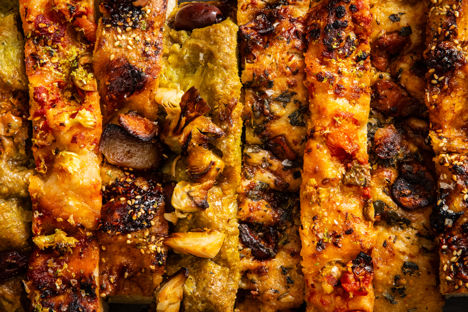What is focaccia?
Focaccia is a bread from the northern Italian region of Liguria. It’s known for being made with lots of olive oil, and having a dimpled surface made by pressing the dough lightly with your fingertips. Some focaccia is thick and fluffy – thick enough to slice in half and use for sandwiches – while other styles are thin and crispy.
Traditionally focaccia is cooked similarly to pizza: it’s a leavened dough that’s spread out thinly, and then baked in a ripping hot oven. However, unlike pizza it’s one even thickness throughout, and doesn’t have a crust. It’s also not as thin as pizza, or quite as leopard spotted. It’s also traditionally topped with a brine of salt, water and olive oil that isn’t used in pizza.
Focaccia changes throughout Italy and throughout Liguria. Some versions are thick and covered in tomatoes (like focaccia Barese) and others are thin and full of stretchy cheese (focaccia di Recco). The version we’ve given below is a focaccia Genovese, made simply with just flour, olive oil and salt. Because focaccia is so simple, a long, slow rise is important to give it flavour.
How do you pronounce focaccia?
Focaccia is pronounced ‘fok-a-chia’, with a hard ‘k’ like 'kit' and a ‘ch’ sound like in ‘cheese’.
What should you eat with focaccia?
This depends on what sort of focaccia you make! Thinner and crispier focaccia is perfect with some antipasto, like thinly sliced ham, or dipped in a sweetened cappuccino for a delicious Ligurian breakfast. Fluffy focaccia is also a great, soft sandwich bread. Cut it in half, and stuff it with prosciutto, rocket, thinly sliced cheese, sun-dried tomatoes – anything you fancy really. You can also get focaccia dolce, or sweet focaccia, which is served with marmalade or chocolate spread.
What is in focaccia?
Despite the fact that focaccia is known for its rich olive oil taste, most of the olive oil goes on top of the dough, and not in the dough mixture. Unlike, say, brioche, it’s actually a very lean dough and then is topped with a generous amount of olive oil before baking.
How to make focaccia Genovese
Metric
Imperial
- 190ml of water, lukewarm
- 20ml of extra virgin olive oil
- 7g of salt
- 1 tsp malt extract, or sugar
- 310g of strong bread flour
- 6g of dried yeast, or 12g fresh yeast
- extra virgin olive oil
- flaky sea salt
- 1 sprig of rosemary, leaves picked and chopped
Method
Remove from the tray and leave to cool on a wire rack (or eat warm straight away)
How do you store focaccia?
Focaccia goes stale fairly quickly – within a couple of days – so it’s best to eat it quickly, and keep it stored in an airtight container at room temperature. On day two or three it will benefit from reheating or being gently toasted in the oven before serving.
Can you freeze focaccia?
Focaccia freezes well, but make sure to keep it well-wrapped to prevent freezer burn. Defrost it and warm it up slightly before serving, to give it the best texture.
How do you reheat focaccia?
Focaccia, especially day-old focaccia, really benefits from being warm when you serve it. It’s best to warm it up in an oven rather than a microwave, to keep the crispy crust. We recommend reheating focaccia in a 180°C (160°C fan) oven for about 10-15 minutes, or until warmed through but not dried out.
Get in touch
Please sign in or register to send a comment to Great British Chefs.



